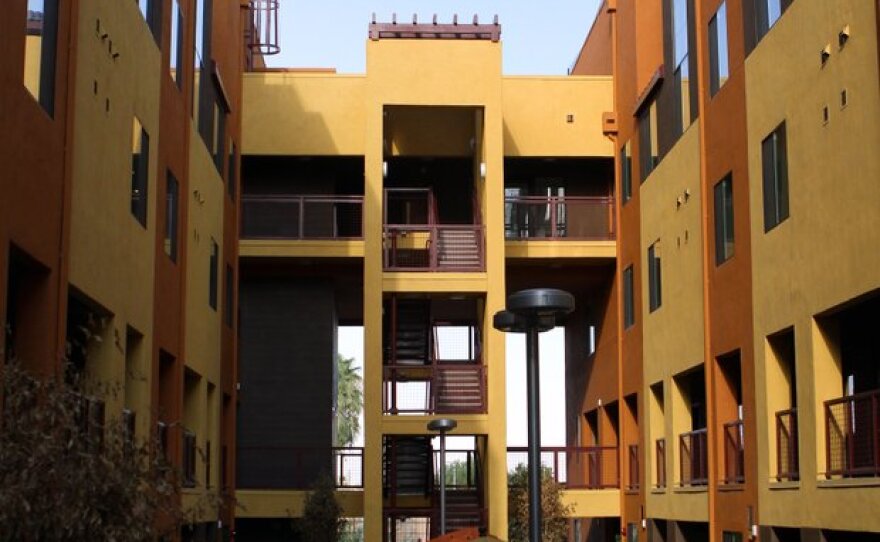A place with one of the harshest climates in the Southwest –- Phoenix -- records more days over 100 degrees than any other major city in the country. But climate models predict metro Phoenix, with its population of four million, will get hotter.
Here in John Larsala’s driveway, the view is bleak.
“You see our tree is dead,” Larsala said. “All these trees are dying because I can’t put water on it.”
The grass is dead too. In fact, there is no grass anymore.
Larsala can’t afford the water on a household income of $18,000 a year. So his children and their friends play basketball in the barren yard until June. That’s when summer finally forces everyone inside.
For three months, Larsala will shut the doors and windows tight. To save money, he’ll soak his kids in a cool bath and delay using the air conditioning until just before bedtime.
“Whether you are inside or outside, the heat costs you money,” Larsala said.
When told that climate scientists say Arizona is only going to get hotter, his face registered a look of surprise.
“It’s going to be hotter than what is right now? Who is gonna live here? How are we gonna live here?” he asked.
Phoenix actually suffers from two heat problems. Desert nights don’t cool down they way they used to because energy from the sun is trapped in roads and buildings. Researchers call this the urban heat island effect. As Phoenix grows, so does the problem.
“We keep thinking we’ll probably see a night when we only get down to 100 as a minimum temperature, which is kind of shocking,” said Nancy Selover, the Arizona state climatologist.
As she stands outside in a low-income neighborhood near Phoenix, she notices the cooling systems in place.
“There are swamp coolers on most of these houses, and some of them probably don’t have air-conditioning,” Selover said.
Swamp -- or evaporative -- coolers are cheaper than air conditioning. But they’re also less effective. Selover said it will become pretty unbearable.
Researchers also predict climate change will make droughts longer and temperatures higher.
Data from the North American Regional Climate Change Assessment Program predict that by 2040, sustained heat waves above 114 degrees will be a yearly crisis in Phoenix -- each one lasting a sweltering three weeks.
“As a desert city, Phoenix is a laboratory to find out what works and doesn't work to mitigate those things,” Selover said.
Does that mean we’ll have to live differently?
“We may well have to live differently,” she said.
And how that might happen is something city officials are starting to think about. One idea is to cover 25 percent of Phoenix with shade trees. But some argue for much greater lifestyle adaptations.
Architect John Meunier studies pre-industrial desert cities around the world. And he brings their lessons here. He thinks the number one thing older cities can teach a new desert city like Phoenix is how to not use a lot of energy and power.
To do that, Meunier says planners could encourage ten times as many people to live around light rail station. Getting more use out of light rail would take cars -- and heat -- off the street.
These people would also live in taller buildings. Meunier says desert cities in Yemen, for example, take advantage of tall buildings to shade narrow streets.
“It’s crucially important. I mean not being exposed to the sun’s direct rays make a great big difference,” Meunier said.
Instead of exposed front yards and backyards, older desert cities employ well-ventilated courtyards. Mediterranean cities paint roads and rooftops white to reflect sunlight. Meunier says it’s the way we’ve built Phoenix that will make us vulnerable.
“I’m not arguing that we should all live at a higher density,” he said. “What I’m arguing is there’s a lot to be gained by having more of us live at higher density.”
For Meunier’s ideas to become reality, developers will have to make the choice to build differently. And in some cases they already have.
Devine Legacy is a housing complex designed for people with lower incomes. It’s right next to the rail line. Every window is dual paned. The building is also super insulated and that means a typical Devine Legacy apartment is about 40 percent more energy efficient.
When you go through the gate you’ll emerge into a courtyard. Four-story buildings rise up on either side of you. There’s shade everywhere. And a breeze moves through. Even on a day when it’s 113 degrees in Phoenix, it doesn’t really feel like it.
“Having a cool place to live is more important to me than food,” Felicia McMullen said.
Before McMullen moved to Devine Legacy, she says she was sick and stressed. She sometimes spent $300 a month to cool her suburban home.
Now she said she doesn’t have that problem. Her last electric bill was $60. The stress is gone.
Ernesto Fonseca helped test Devine Legacy’s energy use before it opened last year.
“People in extreme climates learn to live with it. And that’s part of a resilient society,” Fonseca said.
This idea of resilience is something he thinks about. It means that people who live in Phoenix must do more than try to solve the cause of escalating temperatures -- they also must withstand the changes as they happen.
“We have no choice,” Fonseca said.
That’s why he considers this complex a small victory in what may someday be a more complicated effort to stay cool.





